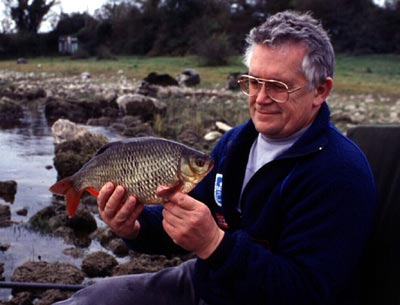You didn’t know what species was in the water, how big they grew. You didn’t know whether your next cast would produce a silver 2oz rudd, a 3lb ‘green’ tench, a bronze crucian carp or a golden 2lb rudd. Every cast was an adventure. But not now, the farmers have long ago realised that farm ponds can be dug out and denatured, the banks flattened, the swims manufactured, and the muddy water filled with small, cheap, cloned carp. Okay, so that is what a lot of anglers want, great for match fishing and excellent for teaching kids tackle skills. They’re good too, for those times when you’ve clocked up a few blanks and you just want to get out there and have it more or less guaranteed that you’ll catch a few fish. But oh, what a loss those small, natural ponds are to the angling world. If only they could have left those alone and dug out completely new ponds for the carp. Then everyone would have been happy. Still a few waters around Right, moan over. There are still a few waters around where you can catch big rudd. Even in this day of hybridisation, where the stillwater roach and rudd are rapidly becoming a single species, most anglers know at least one rudd water. There are still a good number of them in Ireland still, for those of you who are lucky enough to get over there. The rudd is a truly colourful fish, varying from a glistening silver when smaller to a burnished gold as it gets bigger, and with fins ranging through bright orange to blood crimson. Their distinctive protruding lower lip tells us they are built for surface feeding, but they can, and often are, caught on the bottom.
Rudd don’t like bright light. When the sun rises like a polished copper coin above the line of the reedbeds and begins to light the surface of the lake with a reddish glow it is like the kiss of death to rudd fishing. The best time to fish for them is in the evening and into darkness, or early morning before the sun rises. If you can manage to get a shoal of rudd interested in your feed before daylight makes an appearance and clouds prevent the sun from breaking through, then you’re in with a chance of keeping them feeding, on and off, for several hours. Reedbeds are usually best but don’t neglect open water In and around marginal reedbeds are the best spots to find big rudd, and most good rudd waters have many such areas. In the early morning and late evening, and often going well into darkness, the rudd are usually seen priming at the surface along the edge of these reedbeds. This priming is quite often accompanied by loud splashes and sucking noises as they vacuum insects from the surface. Very often the evening feed is frenzied in the first hour or so of this activity, for this is when most insects are spent and lying in the surface film, making easy pickings. The rudd will travel slowly along the line of marginal vegetation and then disappear as the sun rises in the morning, and after an hour or two in the evening. Sometimes though, they will linger over a well-baited spot, specially in warm, dull conditions. The open water should never be ignored, however, for when a warm wind is drifting the edible flotsam across the water, the rudd will follow it, often for several hundred yards and in large shoals. You can easily see these rafts of dead and dying insects. They look like a large patch of surface scum, a dull patch on the otherwise bright surface, and if you spot one in the early morning or late evening, watch out for those tell-tale swirls and splashes of big rudd as they take advantage of these natural larders. Floating and slow-sinking baits and feed little and often The conventional (or should that be traditional?) method for catching big rudd is to present a floating bait at the surface, or to fish with a slow-sinking bait that lingers at the surface long enough to give a surface feeder a chance to snaffle it, and then slowly sinks to tempt the rudd to take ‘on-the-drop’, and, finally, to lie on the bottom appealing to those rudd that feed below the surface fish.
To attract rudd I use brown crumb groundbait and stuff it heavily with crushed hemp so that it continues to burst and mushroom from the bottom long after it has settled there. Tackle and rigs The float rig for big rudd is simplicity itself. All you need is a waggler float that is buoyant enough to carry sufficient shot to reach the swim. The float is set deep enough to fish the bait laid on a few inches following the brief spell it spends at the surface, and the slow journey to the bottom. All the shot except one small dropper is bulked right under the float (or use a loaded waggler with weight built into its base) and the dropper, a BB for flake, and a No. 8 for smaller baits set about mid-depth. Always feather and brake the cast to prevent tangles and to ensure the line from float to bait lies on the surface as straight as possible. Variations of this set-up will have to be made according to casting distance and weather conditions. If there is a massive undertow, for instance, then the loaded waggler will have to be replaced with an unloaded one, the bulk shot set just below mid-depth and the dropper about a foot from the hook. This, of course, will fish the bait on, or close, to the bottom, but when the undertow is that fierce it usually means that there is an equally fierce wind blowing, which will drive the rudd from the surface anyhow. Rudd have a protruding lower lip to facilitate surface feeding, but remember that this peculiarity also makes it easier for them to take popped up baits. So make this one of your ploys and try popping up a bait an inch or so off bottom when conventional laying on is not producing as many fish as you think it should. On especially calm days, and on some days when there is a warm breeze, the rudd will very much favour feeding right at the surface. The dropper shot is then removed and the bait fished right in the surface film. Takes can be absolutely savage and belie the size of the fish, so be very wary when fishing surface baits. Keep the drag set to give line and your reactions finely tuned! I generally use a 13ft or 14ft match rod, closed-face reel, 4lb main line, and a 3.6lb hook-length. Hook size is, as always, according to bait size, with a 10’s for flake and two grains of sweetcorn, and a 14’s or 16’s for maggot, caster, and single grains of corn. Flake is an excellent bait, and can be spiced up when the rudd get wary by tipping it with small redworm, maggot or caster. Flake is especially good because of its natural buoyancy, for it allows you to squeeze more or less air out of it to regulate the speed at which it sinks. For very shy rudd bread-punched flake can be deadly. They don’t hang around for long Takes can sometimes be induced by twitching the bait across the surface an inch or two, and regular casting is much better than leaving baits to lie for too long. Besides, you need to maintain the buoyancy in the flake by renewing it regularly. When rudd are well on feed, they are not difficult to catch. The secret is to make the most of it while they are in the swim and feeding, for they rarely hang around for long once you start hooking a few. They are very skittish fish, spooking quite easily, and all you can hope for then is that other shoals make an appearance. |
Welcome!Log into your account
















